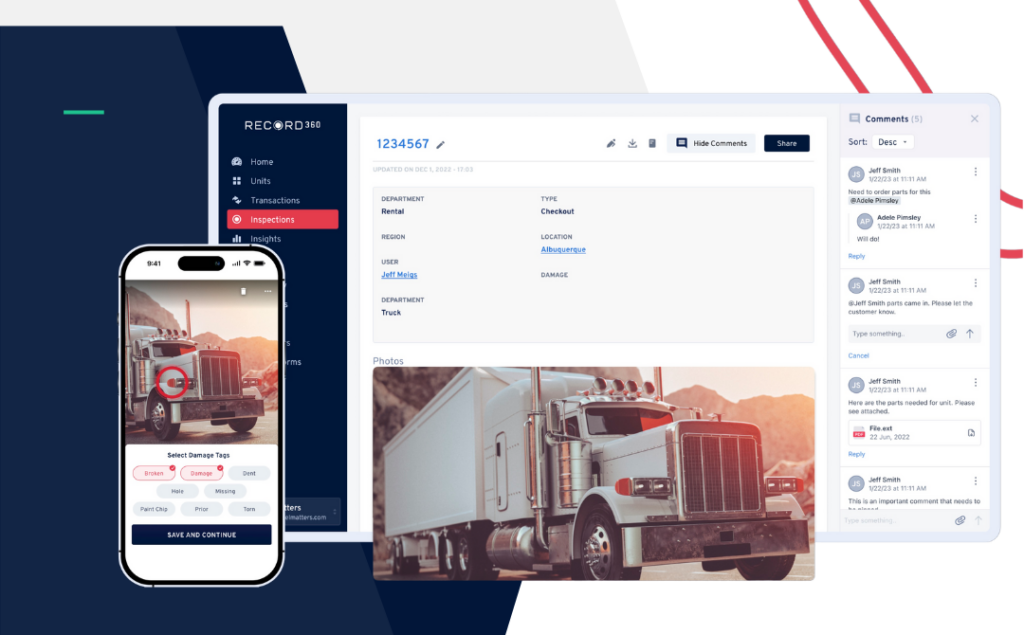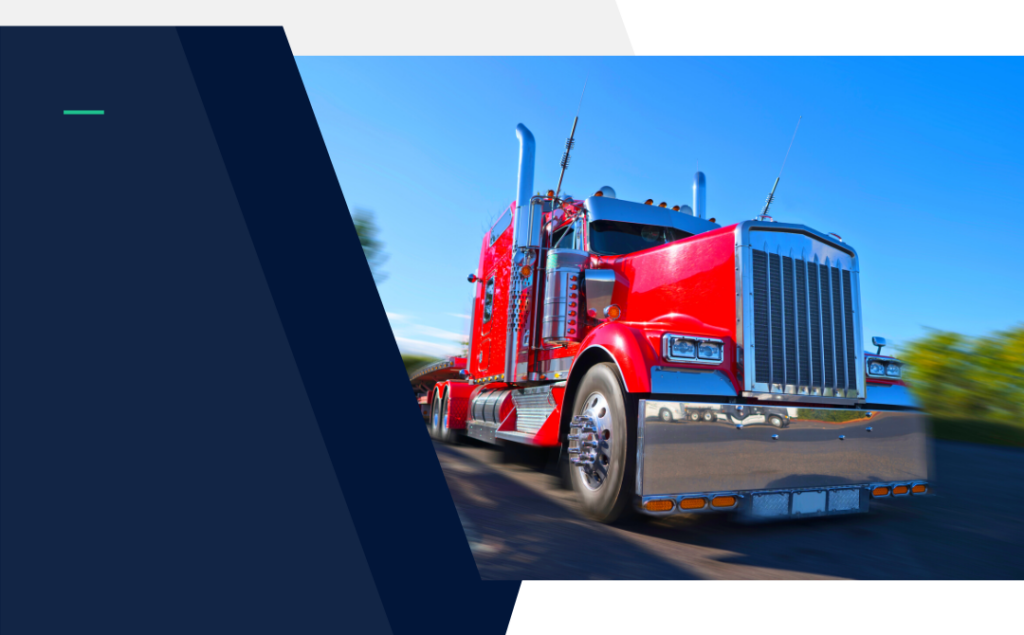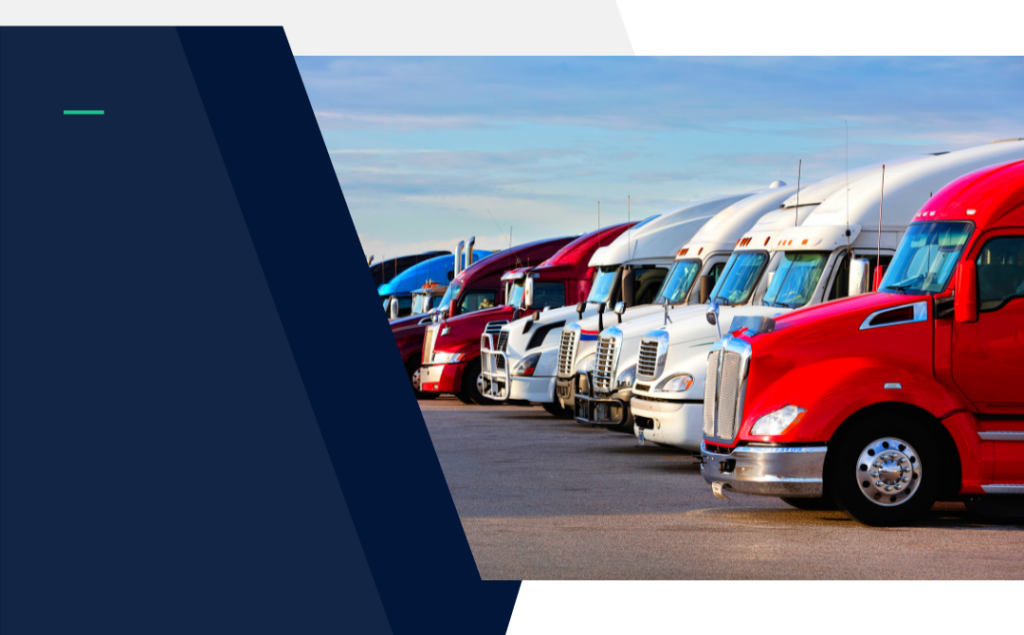Master DOT compliance with semi-truck inspection & maintenance checklists for CMVs. Boost vehicle lifespan and compliance.
While preventative maintenance should be the #1 priority for all rental operators... software tools have been too complex, slow, or non-existent for many teams to manage their fleet effectively.

Record360's comprehensive mobile app lets you create digital inspections, capture photos & videos, and securely access them online.

Seeing is believing with Record360's photo and video evidence. No more questions, just 100% certainty about your equipment's condition.

Set your team up to take immediate action by scheduling emails for failed inspections, assigning tasks, and providing internal comments.
The Record360 mobile app helps you reduce damage disputes with processes that work the way your teams do. We offer the simplest technology program you’ll ever implement so you can build customer trust, guaranteed.
Operate with customer trust & confidence. Record360 unifies your rental, service, and sales departments in a single tool — so you can protect yourself from damage. Create a consistent, transparent process with our digital inspections, tasks, and customer texting platform.




Master DOT compliance with semi-truck inspection & maintenance checklists for CMVs. Boost vehicle lifespan and compliance.
A truck inspection checklist is critical to ensure commercial motor vehicles (CMVs) are safe and in good working order. Inspection checklists vary based on the truck’s type, intended use, and other factors, but many companies and agencies use the Federal Motor Carrier Safety Administration (FMCSA) regulations checklist.
Additionally, there are standardized DOT inspection checklists for semi-trucks and other CMVs. Trucking companies can customize these checklists, and apps like Record360 can digitize and streamline the inspection and maintenance processes. Using a truck inspection sheet, documenting and reporting issues reduces the risk of accidents, increases vehicle lifespan, and ensures compliance with regulations.
The semi-truck inspection checklist isn’t standard. The items that need to be checked depending on the truck’s type, intended use, and other factors. Still, many companies and agencies use the Federal Motor Carrier Safety Administration (FMCSA) regulations’ checklist, which outlines the required inspection items for commercial motor vehicles in the US.
The FMCSA requires that drivers perform a pre-trip inspection of their vehicle and a post-trip inspection if the trip lasts more than one day. The pre-trip inspection includes checking the vehicle’s tires, brakes, lights, horns, steering, suspension, and other components to ensure that they are in proper working order. The post-trip inspection is focused on identifying any damage or issues that may have occurred during the trip, such as fluid leaks or broken components.
The specific inspection items for a commercial motor vehicle can be found in the FMCSA’s “Minimum Periodic Inspection Standards” (Part 396.17) and the “Driver Vehicle Inspection Report” (Part 396.11). However, many trucking companies may use a customized inspection sheet with additional items specific to their fleet or industry.

A Semi Truck DOT Inspection Checklist is a standardized set of items to ensure a commercial motor vehicle (CMV) complies with US Department of Transportation (DOT) regulations.
A typical DOT inspection includes a review of the driver’s paperwork, such as the driver’s license, logbook, and trip records, and a physical inspection of the vehicle. The physical inspection includes reviewing the vehicle’s brake system, coupling devices, fuel system, steering mechanism, lighting devices, tires, and other critical components.
The DOT Inspection Checklist is a standardized list of all the items that must be inspected during a DOT inspection. It includes both required items, such as the brakes and lights, and optional items relevant to a specific industry or type of vehicle.
The DOT Inspection Checklist helps ensure that all commercial vehicles on the road meet minimum safety standards and are operating in compliance with federal regulations. Trucking companies can use the checklist to prepare their vehicles for inspection, and drivers can use it to perform pre-trip inspections and ensure that their vehicles are safe and compliant with the law.

A semi-truck inspection checklist is a list of items that must be inspected on a commercial motor vehicle (CMV) to ensure that it is safe and in good working order. The checklist can be used by drivers, mechanics, and fleet managers to identify and address any issues before they become larger problems.
The specific items on a semi-truck inspection checklist can vary depending on the type of truck and its intended use. However, some common items that may be included on a Trucking Inspection Checklist are:
Trucking companies may customize the semi-truck inspection checklist to meet their specific needs. Some may use a computer or smartphone app to streamline the inspection process and make documenting and reporting issues easier.

A Semi Truck Maintenance Checklist is a comprehensive list of tasks that must be performed regularly to ensure the smooth functioning and longevity of commercial motor vehicles, such as semi-trucks or tractor-trailers. Regular maintenance is crucial to prevent unexpected breakdowns, extend vehicle life, and maintain optimal performance. Using a checklist helps you avoid costly mistakes.
A typical Semi Truck Maintenance Checklist includes changing the engine oil, inspecting and replacing air filters, checking tire pressure and wear, lubricating moving parts, inspecting and replacing brakes, and inspecting the electrical system. It may also include specific tasks based on the vehicle’s make and model, such as inspecting the cooling system or checking the air conditioning.
Maintaining a Semi Truck requires attention to detail and consistency. By regularly performing tasks on the Semi Truck Maintenance Checklist, trucking companies can reduce the risk of accidents, ensure compliance with regulations, and increase the lifespan of their vehicles.

18-Wheeler maintenance refers to the regular upkeep and repair tasks necessary to ensure the safe and reliable operation of a commercial motor vehicle known as an 18-wheeler. 18-wheelers are large trucks consisting of a tractor unit and a trailer with 18 wheels.
Regular 18-wheeler maintenance tasks include changing the engine oil, inspecting and replacing air filters, checking tire pressure and wear, lubricating moving parts, inspecting and replacing brakes, and inspecting the electrical system. Other tasks may include inspecting the transmission, cooling system, and air conditioning. These maintenance tasks are critical to ensure that the 18-wheeler is in good working condition, and they help prevent unexpected breakdowns that could lead to accidents and delays.
Many trucking companies have a routine maintenance schedule for their 18-wheelers to ensure that all necessary maintenance tasks are timely. Regular maintenance is essential to the longevity of the 18-wheeler and can reduce the risk of costly repairs.

Used in over 23 million inspections at 2,000 locations nationwide, Record360’s InspectPro is the #1 inspection app in the heavy equipment and truck industry. Enhance customer satisfaction through accurate damage assessments, build trust, and demonstrate commitment to the customer experience.
Streamline your rental inspection app with Record360. Cut costs, streamline inspections, augment inventory management, and protect your assets from damage—all while keeping your customers happy.
Request a demo of Record360 and discover why the leading rental companies trust Record360 for their inspections.
See why thousands of people across the world trust Record360.